The Future of Streaming: How to Cut Costs & Save Money on Streaming Services in 2025
Prices are going up everywhere, and that includes streaming services. One of the biggest problems with streaming is that you can easily lose track of all your subscriptions and rack up a large monthly bill. This guide shares how to save money on streaming services.
With so many streaming options available now, it can be hard to limit yourself to just one or two. While the cost is usually much lower than a satellite or cable package, paying for multiple streaming services can easily end up costing the same, if not more. With the current financial crisis hitting many households, you might be wondering how to save money on streaming services.
Key Takeaways:
- Streaming packages have taken over from traditional satellite and cable, with the average American family having at least one streaming subscription.
- On-demand streaming services are usually cheaper, but having multiple accounts can result in you paying a lot per month. Plus, live TV streaming can be costly.
- There are lots of ways you can keep costs down while still enjoying streaming, such as using free trials, streaming bundles with phone plans, student discounts and sharing subscriptions.
Many people have already cut the cord on their cable or satellite TV packages, and people continue to do so. This, plus the surge of interest in streaming services during the pandemic, means that streaming is bigger than ever.
The streaming industry has become crowded, with lots of content only available on proprietary platforms. Plus, many services offer original content that you can’t find anywhere else.
Spending on every service probably isn’t a great idea; you likely won’t be able to watch enough content to get your money’s worth. Thankfully, there are ways you can cut your spending on streaming services without sacrificing on content. Keep reading for six tips on how to cut costs, plus expert opinions on what we can expect in the future with streaming.
How to Save Money on Streaming Services: 6 Tips
Let’s get into the different ways you can save money on popular streaming services and steer clear of blowing the household budget.
1. Rotate Which Streaming Service You Use
Depending on your reason for signing up for a particular streaming subscription, you can save money by rotating which ones you pay for. By keeping with the monthly plan, you’re not locked into a lengthy contract, meaning you can cancel whenever you want (and rejoin whenever you want to).
Many people sign up for a streaming platform to watch a specific show. For instance, one report found that 26.25% of its respondents signed up for Disney+ specifically to watch The Mandalorian, and 25.57% signed up for Netflix to watch the new season of Stranger Things.1
There’s nothing wrong with doing this, but what can often happen is that you don’t unsubscribe when you’ve finished watching the show. Done again and again, you can quickly accrue a pretty hefty monthly bill.
The best method is to work out a schedule. Decide when your favorite shows will be back with new episodes and plan which streaming service you need to subscribe to each month.
You can also use streaming apps like ReelGood or JustWatch to work out where you can watch shows for the cheapest price. For instance, a show might be on a paid service in the U.S., but free on BBC iPlayer or ITV Hub in the U.K.
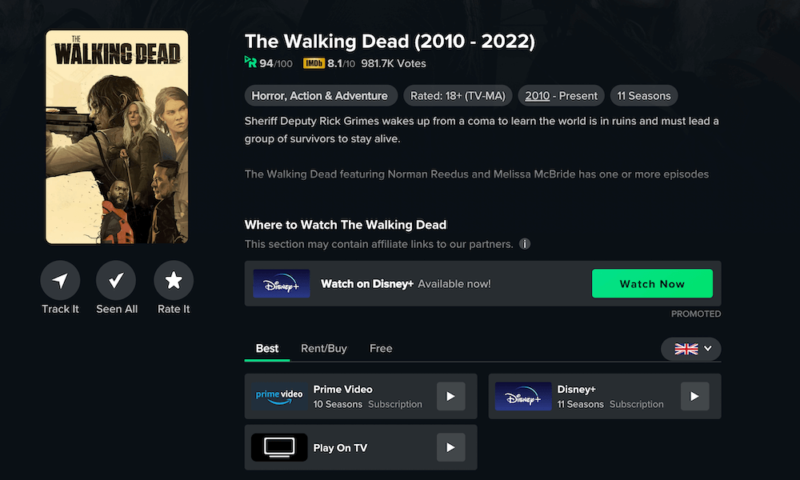
A Parks Associate report found that 36% of U.S. subscribers already “service hop.” If you finish the show early, you can catch up with some other shows before moving on. Hopping helps you avoid paying for a service you aren’t using at the time. Just be sure to cancel before the next billing cycle.2
2. Grab a Bundled Deal
Most streaming services don’t offer a deal directly, but you can often find one bundled with a cell phone contract. For instance, at the time of writing, you can get an ongoing Netflix subscription, six months of Apple TV+ and one year of Paramount+ with selected T-Mobile plans.
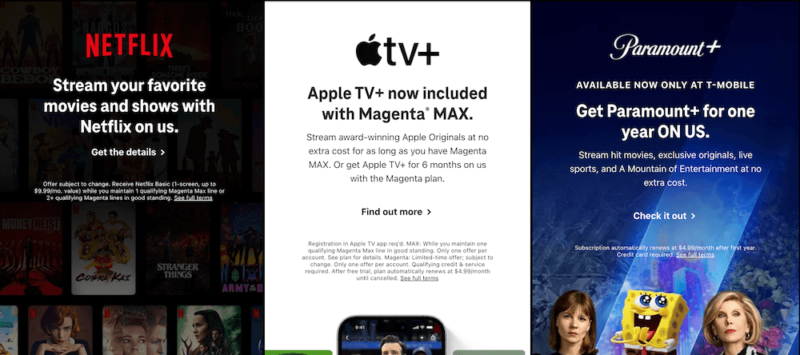
There are likely plenty of other great deals out there too. If you’re someone who already has a cell phone plan or you’re looking to get one, taking advantage of the latest deals can be a great way to save cash in the long run.
You can also get the Disney bundle, which includes Disney+, Hulu and ESPN+. Bundling the three services together costs from $12.99 per month, making it half of the cost compared with subscribing to each individually. Plus, you can get the Disney bundle free with a Verizon Unlimited plan.
Pay Annually
If you’re dead set on which streaming service you want, it’s better to opt for an annual subscription than a monthly one. While some services, such as Netflix, don’t offer an annual plan, if your service of choice does, you can save quite a bit of money. The downside is you’ll need to pay for the entire year upfront.
3. Adjust Your Tier
While most of us would likely prefer an ad-free experience, opting for an ad-supported plan can save you a few bucks. Many streaming services already offer different tiers to suit different budgets.
For instance, Hulu (No Ads) costs $14.99 per month, but you can get the same plan with ads for almost half the price, at $7.99 per month. Paramount Plus offers similar tiers, with its ad-free plan costing $9.99 per month and its ad-supported plan costing half of that, at $4.99.
Netflix rolled out its ad-supported plan at the beginning of November 2022. It’s not available in all countries just yet, but it costs $3 less per month than the ad-free Basic plan.
Of course, Netflix offers four different tiers, each offering better resolution and more simultaneous streams, but you need to ask yourself how many users will be watching at the same time realistically, and if you really need 4K.
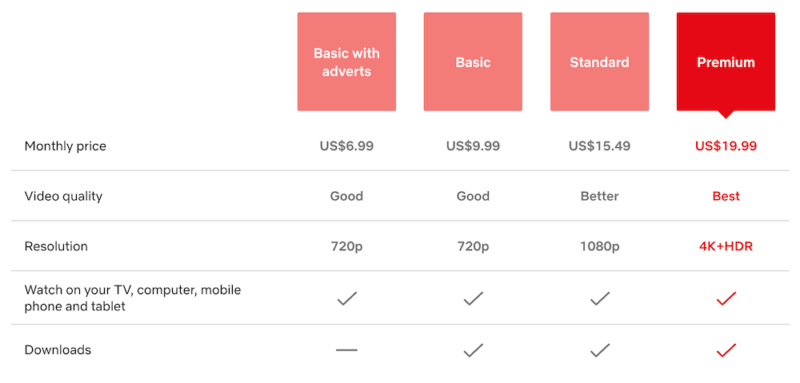
It’s likely that other streaming services will join the ad-supported streaming wave, and if you don’t mind watching an ad here and there, such plans can certainly save you some money.
Move Away From Paid Live TV
On a different note, there are many services that offer live TV streaming along with on-demand content. Although the cost of live TV streaming services is often a lot less than a traditional satellite or cable subscription, they can still eat a good chunk of your money each month.
Plus, what you actually get with such services can vary quite a bit, such as the number of channels. If you insist on sticking with live TV, it might be worth checking what channels other services offer and compare the price.
Let’s take YouTube TV, for instance. You get more than 100 channels, but it costs $65 per month. Hulu + Live TV costs a bit more ($69.99 per month), and you start off with only 75 channels or more depending on your location. However, you also get Disney Plus and ESPN+ bundled with it.
One of the cheapest live TV services you can get is Sling TV, but even that costs at least $40 per month and you get less than 50 channels.
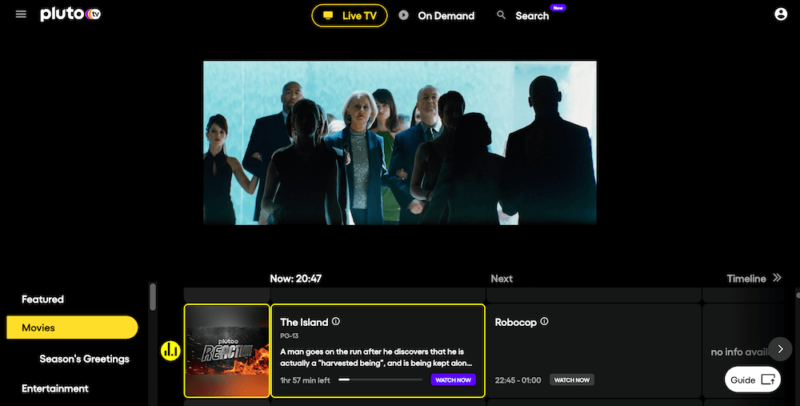
If you want to keep some form of live streaming, but your budget won’t allow for a paid service, you can watch live channels on free streaming services like Pluto TV. You’ll need the best VPN for Pluto TV if you’re outside a country where Pluto TV is available.
You can also install an antenna — after the initial cost of the antenna itself, this will provide live channels 100% free. You’ll be able to pick up channels like CBS, NBC, FOX and ABC, as well as local networks like PBS and news channels.
4. Get Cashback With Credit Card Rewards
You’ve likely already heard of getting cash back with certain credit cards, but many of them specifically offer cash back on streaming subscriptions. Quite simply, you get some money back if you use your cashback credit card to subscribe and pay for certain services. Most cards offer 3-5% cashback, so it’s worth making sure you’re using the right credit card.
The U.S. Bank Cash+ Visa Signature Card gives 5% cashback on up to $2,000 of eligible purchases — including streaming — and there’s no annual fee. Eligible streaming services include Disney+, Hulu and Netflix, but there isn’t a huge range after that. There are plenty of other cards, though, so it’s a good idea to shop around.
The Blue Cash Preferred Card by American Express
One of the best options is the American Express Blue Cash Preferred Card because it has one of the highest cashback rates at 6% uncapped. It also works with a ton of streaming platforms, including Paramount+, Max, Amazon Prime Video, Peacock and Netflix.
There’s also what’s called the Disney Bundle Credit, where you can get back $7 per month back when you use your Blue Cash Preferred Card to sign up and pay for the Disney bundle. This means you’re basically getting half off the standard monthly price, a total savings of $84 per year.
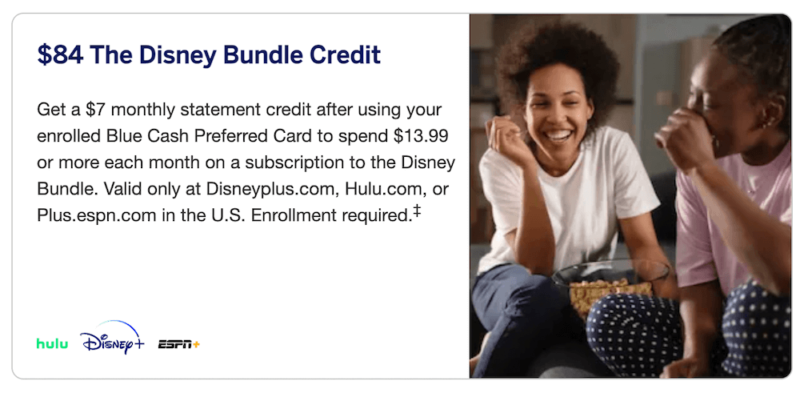
There’s no special sign up process to get the streaming cash back, either. All you need to do is use the Blue Cash Preferred Card as your monthly payment method. You’ll automatically start getting cash back each month, so long as you don’t cancel.
There is one little snag, though — this card has a $95 annual fee. That said, your first year is free, and the card offers cashback on other purchases in travel, gas and supermarket categories as well.
It’s worth signing up even if you only use the card for the first year (while the annual fee is waived), but if you have enough eligible purchases, you could easily earn enough cashback to cover the annual fee and more. Your cashback is deducted directly from your monthly balance, but remember to clear the rest of your credit card balance early to avoid interest.
5. Use Free Trials
While there are some streaming platforms that don’t offer a free trial period at all, including Netflix and Disney Plus, plenty of others do. Free trials can vary anywhere between a week to a month. If you plan your subscriptions well, you could watch TV for months before having to pay.
Hopping from free trial to free trial is one of the best ways to save money with streaming costs. If you’re worried about geoblocks, the best VPNs for IPTV can help you access any streaming services no matter where you are located.
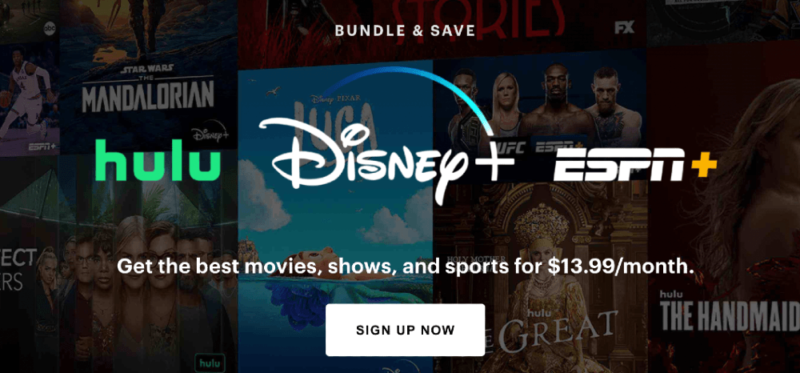
On top of that, some services offer a discount when you try to cancel, and the discount may increase the more you deny the discount offers during the cancellation process. Whether you take the offer or not is up to you, but remember that it only lasts for a limited time.
Whatever you do, remember to keep tabs on when you should cancel. If you lose track, you’ll end up paying for another month, and most services don’t offer a refund.
6. Share Your Subscriptions
Sharing a streaming account is usually frowned upon by streaming services. Netflix even announced a plan to curb password sharing by allowing those who borrow someone’s account to create their own and transfer their preferences over. It also allows account owners to create sub-accounts for extra members that aren’t in the same household at a discounted cost. Learn more in our detailed Netflix password sharing guide.
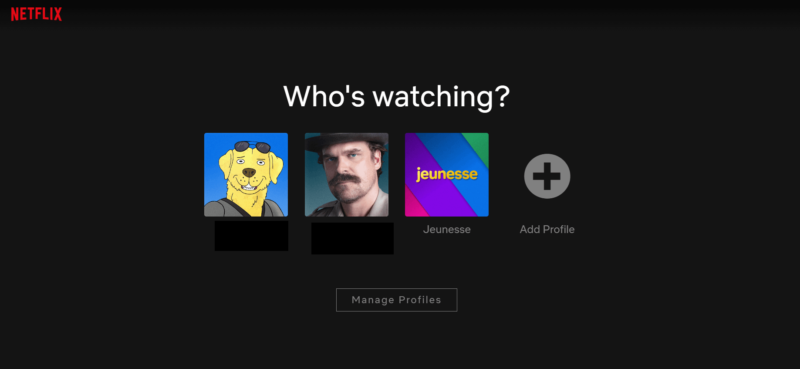
While they may not like it, account sharing is usually ignored by streaming services because there’s nothing services can really do about it. Research found that one in four streamers is borrowing someone else’s account, and that almost 86 million accounts are shared. Account sharing certainly is not a new thing.3
If you have family or friends that want to use the same services as you, you can split the costs. Just don’t overdo it. Sharing with one or two people is one thing, but sharing with your parents, siblings, cousins, grandparents and goodness knows who else might be cause for suspicion.
Watch Out for Screen Limits
On top of that, there’s usually a screen limit in place, meaning only a certain number of people can watch at the same time anyways.
For instance, Netflix’s Basic plan only allows for streaming on one device at a time, whereas its Standard plan allows two. If there are more than two people who want to share and watch, it’s more cost effective to go for the Premium plan, which costs $20 per month and allows four simultaneous streams.
With some services, it may also be a good idea to have multiple users chip in for an annual subscription.
6 Expert Opinions: The Future of Streaming Services & Multiple Subscriptions
These experts look to the future of the streaming industry, and offer their projections on subscriptions, streaming content, ad-based tiers and bundles.
More Ad-Tier Plans
Chuck Tryon, Associate Professor, Film and Media Studies at Fayetteville State University
Cyclical Subscribing & Intro Deals
Cody T. Havard, Professor, Sports and Leisure Commerce at the University of Memphis
This is evidenced in my opinion by the drop in subscriptions for Netflix in the first quarter, and then increase in subscriptions recently. So, on some level, I think turnover is to be expected. I also think that with the introduction of ad-supported tiers, we will see an increase (not sure how much) in subscriptions.
Second, it has been well documented and discussed by experts in the entertainment industry that people will have a few services they will choose to pay for on a monthly or annual basis — with some other services being thrown in on perhaps an intermittent basis, depending on what show is available on a service at any given time. (People subscribe for a month and cancel once they finish watching the show(s) they are interested in.)
This is the new competition ground for streaming services. The largest brands like Netflix, Disney+, and Amazon Prime Video seem to have an advantage because of longevity of existence, original programming, or a strong library content (Disney in particular).
The challenge for other streaming brands is to engage with consumers in a way that leads to strong loyalty and annual or recurring subscriptions.
I do not see streaming services lowering subscription costs because that typically is seen as a negative thing in consumer behavior. People pay more for brands they think are better, therefore price influences the prestige consumers have of a brand or product. We see this frequently in automobile brands, in which versions of cars are very similar except for a few additions and most importantly the logo on the vehicle.
I do believe we will continue to see — and possibly an increase at times — streaming services offering deals to get people to subscribe. This has been done either through lower subscription costs (Hulu did this in 2022) or bundling with other providers such as mobile phones and music services.”
Consolidation & Higher Costs
Derek Johnson, Department Chair, Media and Cultural Studies, Professor at the University of Wisconsin-Madison
Many of these services aren’t yet turning a profit for their parent companies at current rates. I think it’s more likely we’d see consolidation — with fewer services ultimately being offered, and maybe at even higher costs than we see now. Particularly if there are any mergers or acquisitions that see any of these companies join forces.
I have no idea how to actually save money on streaming services because I’m not sure it is possible in the long term. To get what you want, you might need to pay the same as a cable/satellite package.
The answer for how to save money is to be less interested in the one or two exclusive titles that would motivate you to sign up for each service, and just subscribe to fewer. Or rely on free ad-supported services like Pluto TV (if you can settle for mostly old reruns presented linearly).”
Ad-Based Revenue vs Higher Subscription Rates
Wendy W. Moe, Dean’s Professor of Marketing, Robert H. Smith School of Business, University of Maryland, College Park
The original Netflix product offered a limited number of movies per month for a fixed subscription rate. Of course, there was also an unlimited option, but that was more expensive and Netflix had to carefully weigh the price of the subscription against the likely cost of providing the licensed content.
Now, the industry is moving toward a model where these platforms are creating their own content and providing that to their subscribers. As a result, the cost of serving these subscribers are increasing while the subscription fees they are getting remains relatively fixed.
At the same time, these services are trying to build loyalty with their viewers and encouraging them to use their service more… that is, they want consumers to consume more content at the same fixed subscription rate. Again, this increases their costs without increasing their revenues. So it makes sense that these services are considering advertising to help financially support their content.
The alternative is raising subscription rates, which consumers may not tolerate as well. This change would take the industry full circle and the streaming services will have the same business model as the ‘old school’ broadcast networks where they invest in content (e.g., producing series, licensing movies, paying for broadcast rights to sporting events) and pay for it with advertising revenue.”
Fewer Originals & More Already Produced Movies
Josep Valor-Sabatier, Professor of Operations, Information and Technology at the University of Navarra
Companies like Netflix, that have been gathering data for a long time know what shows produce more engagement, and I believe they have a better chance of deciding which shows not to invest in. Companies that rely on movies already produced, either classicals or their own vault, can reduce prices.
The third category, those that basically serve live TV (like Sling), are in a situation that will depend on the costs of those channels. If the contract, –that I do not know details — with, say, NBC is such that NBC charges only for the number of Sling subscribers, then they can reduce prices if these costs plus tech costs are covered.
My impression is that add-supported services will stay with us for a long time. Ads have supported television since its inception, and I do not see why it should go away.
Viewers will have to choose. It is true that bundles are becoming popular, but Hulu/Disney/ESPN all belong to the same parent company. There might be associations of complementary services that appeal to different members of a household that could presumably create a bundle. This is particularly useful if the cost structure of both services is fixed.”
Shifting Subscriber Dynamics
Kimberly Owczarski, Associate Professor, Film, Television and Digital Media at Schieffer College
In return, these services will have to offer more promos to draw back these consumers and new ones, and offer more original, one-of-a-kind programming to keep them there. We are unlikely to see content budgets for streamers go down any time soon, especially as more of them wade into live sports programming which is notoriously expensive.
Many families have subscribed to services like Netflix to avoid ads during children’s programming. It’s unlikely that they will switch to ad-based tiers despite their cheaper cost. For those without children, these consumers have grown accustomed to watching their programs and movies without interruption.
It’s likely they will remain in the ad-free tiers with their preferred service(s) as well, though we may see an increase in consumers experimenting with new streaming services through these cheaper, ad-supported tiers. The lower cost may be enough to justify a short-term commitment for a show or film they want to access.
We will continue to see bundling within the big media conglomerates, but we are unlikely to see bundles across these companies any time soon. Building a branded online ecosystem takes time and a large financial investment and these companies will not abandon their streaming services easily.
The big media companies have an advantage over their cable and satellite competitors in that they can push their streaming services into new international markets to continue adding subscribers.
Cable and satellite companies cannot compete with the potential market size of streaming services since they are locally, regionally, and/or nationally based. It will become more and more difficult to compete with streaming, especially with the high costs of those subscriptions.”
Final Thoughts: Ways to Save Money With Streaming
We hope this guide has helped you understand how you can save money on streaming services. The most important things you can do is keep an eye on what you’re subscribed to and make sure you stick to a budget. If you don’t, your streaming service bill can spiral out of control very quickly.
Do you have any tips on how to save money on streaming services? Which method works best for you? Do you prefer ad-supported plans over more expensive ad-free plans? Let us know in the comment section, and thank you for reading.
Sources:
- FinanceBuzz.com – streaming statistics
- Parks Associates report
- Cordcutting.com – subscription sharing research
FAQ
If you only want to watch on-demand content, it’s usually cheaper to pay for streaming services. However, adding live TV streaming can drive the cost up.
There are plenty of on-demand streaming services available for less than $10, including Netflix, Hulu (with Ads), Disney Plus and Amazon Prime Video. They all have a good variation of content, but for the best mix of categories and sheer volume of content compared with cost, Netflix is likely your best bet.
The only true bundle we know of is the Hulu/Disney+/ESPN+ bundle. However, there are plenty of services that offer add-ons, such as an Max add-on for Hulu.


